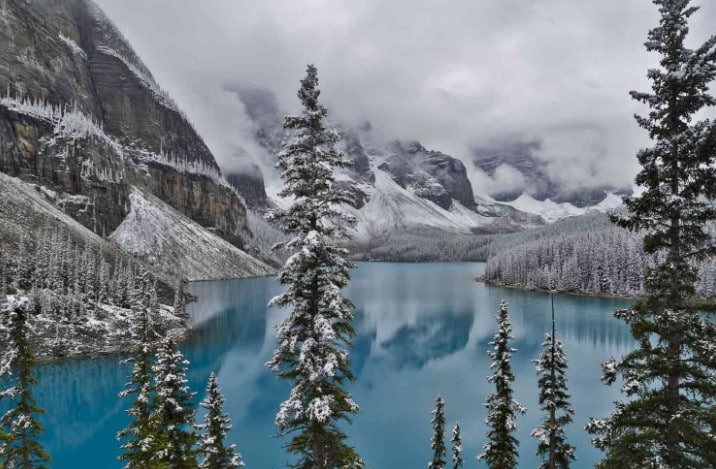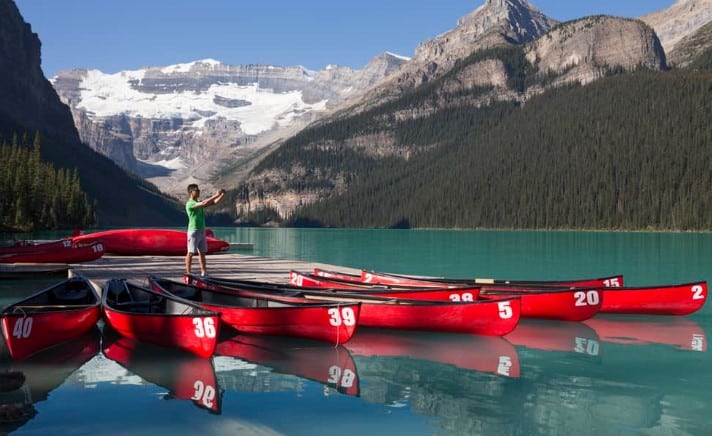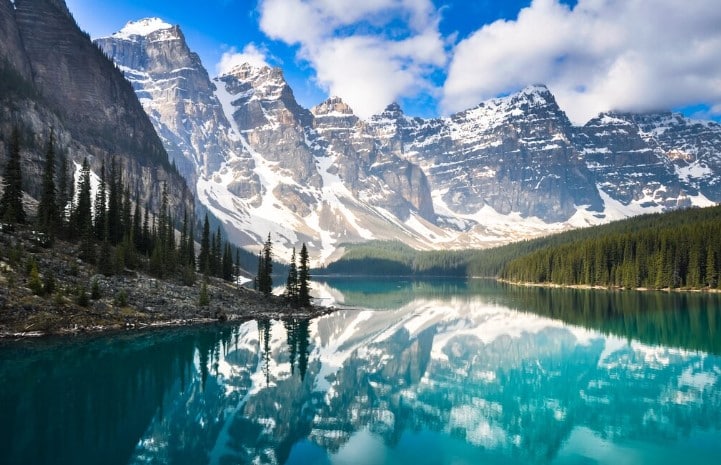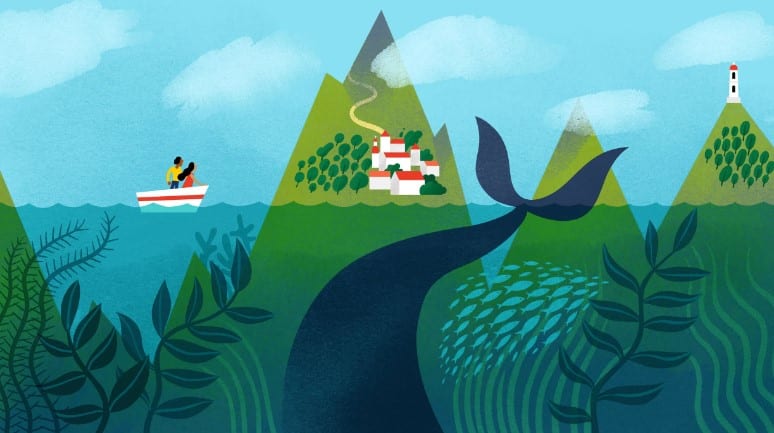Best Time to Visit Canada – Canada is a vast country with a diverse range of climates and landscapes, making it a year-round destination.
However, choosing the best time to visit Canada depends on what you want to experience, whether it’s the vibrant colors of fall in Quebec, the summer festivals in Toronto, or the winter wonderland of Banff.
This site Globetraveo will help you determine the ideal time to visit Canada based on your interests and travel plans.
Understanding Canada’s Climate and Seasons

Canada experiences four distinct seasons: winter, spring, summer, and fall. Each season offers unique experiences, and the Best Time to Visit Canada varies depending on your interests.
Winter (December to February): Winter in Canada is a wonderland for those who enjoy snow sports and winter activities.
Popular destinations like Banff, Whistler, and Quebec City come alive with skiing, snowboarding, and ice festivals.
However, be prepared for cold temperatures, especially in the northern regions.
Spring (March to May): Spring is a beautiful time to visit Canada, as the country begins to thaw and flowers bloom.
This season is perfect for exploring cities like Vancouver and Toronto before the summer crowds arrive.
However, the weather can be unpredictable, so packing layers is advisable.
Summer (June to August): Summer is the peak tourist season in Canada, with warm temperatures and long days.
This is the best time to visit Canada’s national parks, enjoy outdoor activities, and explore cities like Ottawa, Montreal, and Toronto. T
he Canadian Rockies and the Great Lakes are especially stunning during this time.
Fall (September to November): Fall in Canada is famous for its breathtaking fall foliage, particularly in Quebec and Ontario.
This is the best time to visit if you want to experience the vibrant colors of autumn. The weather is cool and crisp, making it ideal for hiking and exploring the countryside.
Best Time to Visit Canada by Region

Canada’s vast geography means that each region experiences the seasons differently. For instance, coastal areas like Vancouver have milder winters, while the Prairies face more extreme temperatures.
Understanding these regional variations is key to planning your trip. In addition to seasonal activities, Canada’s cultural events also vary throughout the year.
Winter offers festive markets and ice sculpture competitions, while summer hosts numerous music festivals and outdoor events across the country. Timing your visit with these events can enhance your experience.
Lastly, considering the seasonal daylight variations is crucial. In summer, the northern regions enjoy nearly 24 hours of daylight, known as the Midnight Sun, whereas winter brings longer nights, especially in places like Yukon.
This can significantly impact your daily itinerary and activities. Canada’s diverse regions offer different experiences depending on the season.
Here’s a breakdown of the best times to visit various parts of Canada:
Best Time to Visit Ottawa and Eastern Canada
- Best Time to Go to Ottawa: The best time to visit Ottawa is from late spring to early fall (May to October). During this period, the weather is mild, and the city hosts several festivals, including the famous Tulip Festival in May.
- Best Time to Visit Quebec for Fall Colours: The fall season (late September to early October) is the ideal time to visit Quebec to witness the stunning fall colors. The vibrant reds, oranges, and yellows of the leaves are a sight to behold.
- Best Time to Visit Eastern Canada: Eastern Canada, including Quebec and Ontario, is best visited in the fall (September to October) for the foliage and in the summer (June to August) for warm weather and festivals.
For winter enthusiasts, visiting Ottawa and Eastern Canada from December to February offers a magical experience.
Winterlude, Ottawa’s iconic winter festival, features ice sculptures, skating on the Rideau Canal, and various outdoor activities, making it an excellent time for visitors who enjoy the snow and cold weather.
Springtime in Eastern Canada, particularly in April and May, is also a delightful season to explore the region.
As the snow melts and flowers begin to bloom, the landscape comes alive with vibrant colors.
This period is less crowded, providing a more peaceful and intimate experience for sightseeing and enjoying the natural beauty of the area.
Best Time to Visit Western Canada and the Canadian Rockies
The best time to visit Western Canada and the Canadian Rockies largely depends on what you want to experience.
For those seeking outdoor activities like hiking, biking, and sightseeing, the months from June to September offer warm weather and stunning, snow-free landscapes.
During this period, the scenic beauty of places like Banff and Jasper National Parks is at its peak, with clear skies and vibrant alpine meadows.
It’s also the ideal time for wildlife spotting, as bears, elk, and moose are more active, making it perfect for nature enthusiasts.
However, if you’re looking for a magical winter wonderland experience, visiting from December to March is ideal. The Canadian Rockies become a paradise for skiing,
Snowboarding, and ice skating, especially in resorts like Lake Louise and Whistler. Winter also offers a quieter, less crowded experience, with the added bonus of witnessing frozen waterfalls and snowy mountain peaks.
Each season brings its own charm, making Western Canada a year-round destination depending on your travel preferences.
- Canadian Rockies Best Time to Visit: The Canadian Rockies are best visited in the summer (June to August) when the weather is warm and the hiking trails are accessible. However, winter (December to February) is also popular for skiing and snowboarding.
- Best Time to Visit Banff: Banff is a year-round destination, but the best time to visit depends on your activities. Summer (June to August) is perfect for hiking and sightseeing, while winter (December to February) offers excellent skiing and snow activities.
Good Time to Visit Toronto and Niagara Falls
- Good Time to Visit Toronto and Niagara Falls: The best time to visit Toronto and Niagara Falls is from late spring to early fall (May to October). During this period, the weather is pleasant, and you can enjoy outdoor activities and attractions.
- Best Day of the Week to Visit Niagara Falls Canada: Midweek visits (Tuesday to Thursday) are ideal for avoiding crowds at Niagara Falls. The fall season (September to October) is also a great time to witness the falls surrounded by autumn foliage.
Best Time to Visit Canada for Winter Activities
- Best Place to Visit in Canada for Christmas: Quebec City is one of the best places to visit in Canada for Christmas. The city’s European charm, festive decorations, and Christmas markets create a magical holiday atmosphere.
- Best Time to Visit Ontario Canada for Winter Sports: Ontario offers excellent winter sports opportunities, and the best time to visit is from December to February. Blue Mountain and Mont Tremblant are popular destinations for skiing and snowboarding.
You can also read : Budget Travel in Australia: Explore on a Dime
Real-World Examples and Product Comparisons

When planning your trip to Canada, timing is crucial to ensure you get the most out of your visit. Here are some tools and resources that can help you make the best decisions:
1. Seasonal Weather Apps
Seasonal weather apps are essential tools for anyone looking to stay informed about changing weather conditions throughout the year. These apps provide real-time updates and forecasts tailored to specific seasons, helping users plan their activities accordingly.
With features such as severe weather alerts, temperature tracking, and detailed radar maps, seasonal weather apps ensure that you are always prepared for whatever Mother Nature has in store.
Many of these apps also offer customizable notifications, allowing users to receive alerts for their preferred locations, whether at home, work, or on vacation. By utilizing a seasonal weather app, you can make informed decisions about your outdoor plans, ensuring a safer and more enjoyable experience, no matter the season.
- Product Name: WeatherCAN
- Features: WeatherCAN is a Canadian weather app that provides accurate weather forecasts, alerts, and warnings. It’s particularly useful for planning your trip around Canada’s diverse weather patterns.
- Pros: Real-time updates, detailed forecasts, available in multiple languages.
- Cons: Requires internet access for updates.
- Price: Free
- Where to Buy: Download WeatherCAN App
- Benefit: Helps you stay informed about weather conditions, ensuring you pack appropriately and plan your activities accordingly.
2. Travel Insurance
Travel Insurance provides peace of mind by covering unexpected events during your trip, such as medical emergencies, trip cancellations, or lost luggage.
Whether you’re traveling domestically or internationally, a comprehensive travel insurance plan ensures financial protection and support, allowing you to focus on enjoying your journey without worry.
When planning your next adventure, consider the importance of Travel Insurance as an essential safety net for your trip.
Not only does it safeguard you against unforeseen circumstances, such as medical emergencies and lost baggage, but it also offers crucial assistance in navigating the complexities of travel disruptions.
By opting for a reliable travel protection plan, you secure your investment and gain access to resources that can help mitigate the stress of unexpected events.
- Product Name: Manulife Travel Insurance
- Features: Offers coverage for trip cancellations, medical emergencies, and travel delays. Essential for peace of mind when traveling to Canada, especially during winter months.
- Pros: Comprehensive coverage, easy claims process.
- Cons: Higher premiums for older travelers.
- Price: Varies depending on coverage
- Where to Buy: Get Manulife Travel Insurance
- Benefit: Provides financial protection and support during unexpected travel disruptions, ensuring a stress-free trip.
3. Canada Rail Passes
- Product Name: VIA Rail Canada Pass
- Features: Offers unlimited train travel within a specified time period, perfect for exploring Canada’s vast landscapes.
- Pros: Flexible travel, affordable for multiple trips.
- Cons: Limited to VIA Rail routes.
- Price: Starts at $299 CAD
- Where to Buy: Purchase VIA Rail Canada Pass
- Benefit: Ideal for those who want to explore multiple regions of Canada by train, offering convenience and savings.
4. Guided Tours
- Product Name: G Adventures Canada Tours
- Features: Offers a variety of guided tours across Canada, including trips to the Rockies, Eastern Canada, and the Arctic.
- Pros: Expert guides, small group sizes, immersive experiences.
- Cons: Fixed itineraries, higher cost.
- Price: Starting from $1,000 CAD
- Where to Buy: Explore G Adventures Canada Tours
- Benefit: Ideal for travelers looking for structured and informative experiences with local insights and hassle-free planning.
5. Accommodation Booking Platforms
- Product Name: Booking.com
- Features: Provides a wide range of accommodation options across Canada, including hotels, hostels, and vacation rentals.
- Pros: Extensive selection, user reviews, competitive pricing.
- Cons: Some properties have non-refundable policies.
- Price: Varies by property
- Where to Buy: Book Your Stay on Booking.com
- Benefit: Easy to find and compare accommodation options across Canada, ensuring you get the best deal for your stay.
You can also read : Essential Packing Tips for Europe: Travel Smart and Light
Benefits of Visiting Canada During Different Seasons
Visiting Canada during different seasons offers distinct experiences and benefits:
- Winter: Ideal for winter sports enthusiasts. The snow-covered landscapes create a magical setting, perfect for activities like skiing, snowboarding, and ice skating.
- Spring: A quieter season with fewer tourists. Spring is perfect for exploring cities and enjoying the blooming gardens and parks.
- Summer: The most popular season for tourists. Summer offers warm weather, making it ideal for outdoor activities like hiking, camping, and exploring national parks.
- Fall: Known for its stunning fall foliage. This is the best time for photographers and nature lovers to capture the beauty of Canada’s landscapes.
You can also read : Essential Solo Travel Safety Tips: Journey with Confidence
How to Buy and Where to Buy Travel Products
When planning your trip to Canada, it’s important to have the right tools and resources. Here’s how you can purchase the products mentioned above:
- Seasonal Weather Apps: Available for download on app stores (Apple App Store, Google Play).
- Travel Insurance: Purchase directly from insurance providers’ websites, like Manulife.
- Canada Rail Passes: Buy directly from VIA Rail’s official website or authorized travel agents.
- Guided Tours: Book tours through travel agencies or directly on the G Adventures website.
- Accommodation: Use platforms like Booking.com to find and book your stay.
By utilizing these resources, you can ensure a well-organized trip with access to essential services and products.
You can also read : Top Eco-Friendly Travel Tips: Travel Sustainably and Responsibly
FAQs
1. What is the best time to visit Canada for outdoor activities? The best time to visit Canada for outdoor activities is during the summer (June to August) when the weather is warm and most trails and parks are accessible.
2. Is winter a good time to visit Canada? Yes, winter is a great time to visit Canada if you enjoy snow sports and winter festivals.





